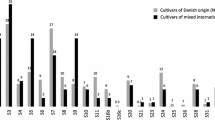Summary
The polymerase chain reaction (PCR) can be used to detect polymorphisms in the length of amplified sequences between the annealing sites of two synthetic DNA primers. When the distance varies between two individuals then the banding pattern generated by the PCR reaction is essentially a genetic polymorphism and can be mapped in the same way as other genetic markers. This procedure has been used in a number of eukaryotes. Here we report the use of PCR to detect genetic polymorphisms in cereals. Known gene sequences can be used to design primers and detect polymorphic PCR products. This is demonstrated with primers to the α-amylase gene family. A second approach is to use semi-random primers to target diverse regions of the genome. For this purpose the consensus sequences at the intron-exon splice junctions were used. The targeting of the intronexon splice junctions in conjunction with primers of random and defined sequences, such as α-amylase, provides a source of extensive variation in PCR products. These polymorphisms can be mapped as standard genetic markers.
Similar content being viewed by others
References
Baulcombe DC, Huttly AK, Martienssen RA, Barker RF, Jarvis MG (1987) A novel wheat α-amylase gene (α-Amy3). Mol Gen Genet 209:33–40
Botstein D, White RL, Skonic M, David RW (1980) Construction of a genetic linkage map in man using restriction fragment length polymorphisms. Am J Hum Genet 32:314–331
Brown JW (1986) A catalogue of splice junction and putative branch point sequences from plant introns. Nucleic Acids Res 14:9549–9559
Brown JW, Feix G, Frendewey D (1986) Accurate in vitro splicing of two pre-mRNA plant introns in a HeLa cell nuclear extract. EMBO J 5:2749–2758
Chandler PM, Zwar JA, Jacobsen JV, Higgins TJV, Inglis AS (1984) The effects of gibberellic acid and abscisic acid on α-amylase mRNA levels in barley aleurone layers studies using an α-amylase cDNA clone. Plant Mol Biol 3:407–418
D'Ovidio, R, Tanzarella OA, Porceddu E (1990) Rapid and efficient detection of genetic polymorphism in wheat hrough amplification by polymerase chain reaction. Plant Mol Biol 15:169–171
Erlich HA (1989) PCR technology: principles and applications for DNA amplification. Stockton Press, New York
Flavell RB, Bennett MD, Smith JB, Smith DB (1974) Genome size and the proportion of repeated nucleotide sequence DNA in plants. Biochem Genet 12:257–269
Goodall GJ, Filipowicz W (1989) The AU-rich sequences present in the introns of plant nuclear pre-mRNAs are required for splicing. Cell 58:473–483
Hawkins JD (1988) A survey on intron and exon length. Nucleic Acids Res 16:9893–9905
Huttly AK, Martienssen RA, Baulcombe DC (1988) Sequence heterogeneity and differential expression of the α-Amy2 gene family in wheat. Mol Gen Genet 214:232–240
Huynh TV, Young RA, Davis RW (1985) Constructing and screening cDNA libraries in λgt10 and λgt11. In: Glover DM (ed) DNA cloning: a practical approach, vol 1. IRL press, Oxford, pp 49–78
Islam AKRM, Shepherd KW, Sparrow DHB (1981) Isolation and characterization of euplasmic wheat-barley chromosome addition lines. Heredity 46:161–174
Kan Y, Dozy A (1978) Antenatenal diagnosis of sickle-cell anaemia by DNA analysis of amniotic-fluid cells. Lancet 2:910–912
Knox CAP, Sonthayanaon B, Chandra GR, Muthukrishnan S (1987) Structure and organization of two divergent α-amylase genes from barley. Plant Mol Biol 9:3–17
Lai EC, Stein JP, Catterall JF, Woo SLC, Mace ML, Means AR, O'malley BW (1979) Molecular structure and flanking nucleotide sequences of the natural chicken ovomucoid gene. Cell 18:829–842
Lazarus CM, Baucombe DC, Martienssen RA (1985) α-Amylase genes of wheat are two multigene families which are differentially expressed. Plant Mol Biol 5:13–24
Litt M, Luty JA (1989) A hypervariable microsatellite revealed by in vitro amplification of a dinucleotide repeat within the cardiac muscle actin gene. Am J Hum Genet 44:397–401
Maniatis T, Fritsch EF Sambrook, J (1982) Molecular cloning: a laboratory manual. Cold Spring Harbor Press, Cold Spring Harbor, N.Y.
Mullis KB, Faloona F (1987) Specific synthesis of DNA in vitro via a polymerase catalysed chain reaction. Methods Enzymol 155:335–350
Muthukrishnan S, Gill BS, Swegle M, Chandra GR (1984) Structural genes for α-amylase are located on barley chromosomes 1 and 6. J Biol Chem 259:13637–13639
Nelson DV, Ledbetter SA, Corbo L, Victoria MF, Ramiro RS, Webster TD, Ledbetter DH, Caskey CT (1989) Alu polymerase chain reaction: A method for rapid isolation of human-specific sequences from complex DNA sources. Proc Natl Acad Sci USA 86:6686–6690
Saiki RK (1989) The design and optimization of the PCR. In: Erlich HA (1989) PCR technology: principles and applications for DNA amplification. Stockton Press, New York, pp 7–15
Saiki RK, Scarf S, Faloona F, Mullks KB, Horn GT, Erlich HA, Arnheim N (1985) Enzymatic amplification of beta-globin genomic sequences and restriction site analysis for diagnosis of sickle-cell anemia. Science 230:1350–1354
Skolnick MH, Wallace RB (1988) Simultaneous analysis of multiple polymorphic loci using amplified sequence polymorphism (ASPs). Genomics 2:273–279
Sommer R, Tautz D (1989) Minimal homology requirement for PCR. Nucleic Acids Res 17:6749
Streeck RE, Hobom G (1975) Mapping of cleavage sites for restriction endonucleases in λdv plasmid. Eur J Biochem 57:596–606
Tanksley SD, Orton TJ (1983) Isozymes in plant genetics and breeding. Elsevier, Amsterdam
Tanksley SD, Young ND, Paterson AH, Bonierbale MW (1989) RFLP mapping in plant breeding: new tools for an old science. Bio/technology 7:258–264
Tautz D (1989) Hypervariability of simple sequences as a general sources for polymorphic DNA markers. Nucleic Acids Res 17:6463–6471
Weber JL, May PE (1989) Abundant class of human DNA polymorphisms which can be typed using the polymerase chain reaction. Am J Hum Genet 44:388–396
Williams JGK, Kubelik AR, Livak KJ, Rafalski JA, Tingey SV (1990) DNA polymorphisms amplified by arbitrary primers are useful as genetic markers. Nucleic Acids Res 18:6531–6535
Wyman A, White R (1980) A highly polymorphic locus in human DNA. Proc Natl Acad Sci USA 77:6754–6758
Author information
Authors and Affiliations
Additional information
Communicated by G. Wenzel
Rights and permissions
About this article
Cite this article
Weining, S., Langridge, P. Identification and mapping of polymorphisms in cereals based on the polymerase chain reaction. Theoret. Appl. Genetics 82, 209–216 (1991). https://doi.org/10.1007/BF00226215
Received:
Accepted:
Issue Date:
DOI: https://doi.org/10.1007/BF00226215




